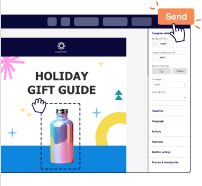- Premium features included
- No hidden costs or usage limits
- Scale from startup to enterprise


No Credit Card Required. Cancel Anytime.
No Credit Card Required. Cancel Anytime.

A newsletter platform mainly focuses on sending updates, but an email marketing tool is built for full campaigns. It lets you create email campaigns, manage email workflows and advanced marketing automation, set up email sequences, and track results with analytics. You can run promotional emails and welcome emails from the same dashboard — making it an all-in-one solution for growing businesses and tracking results with analytics.
Our email marketing service combines powerful automation features, contact list management, and email segmentation to help you target the right audience. It’s perfect for businesses looking to send newsletters, automate transactional emails, and design campaigns with ease using a user friendly interface and intuitive email editor.
Absolutely! Our drag and drop editor is perfect for beginners and pros alike. You can quickly build email marketing campaigns without coding skills. This intuitive email editor saves time and ensures every message is polished, branded, and ready to send.
Our advanced marketing automation allows you to create complex email workflows and email sequences triggered by customer behavior. You can combine automation features like segmentation, personalization, and A/B testing to run highly effective promotional emails or nurture series that convert leads into loyal customers.
Yes — you can send transactional emails such as order confirmations, shipping updates, and password resets while also running email marketing campaigns. Everything is managed in one email marketing service, so you don’t need separate tools.
Our platform provides robust contact list management and email segmentation options. You can group subscribers by demographics, engagement level, or past purchases to create email campaigns that are highly personalized and more likely to convert.
Definitely! You can send newsletters, trigger automated follow-ups, and build entire email sequences using our automation features. Combined with email workflows, this helps you stay connected with your audience.